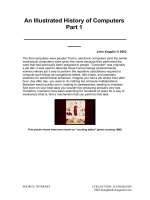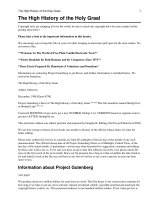HISTORY OF COMPUTERS
Bạn đang xem bản rút gọn của tài liệu. Xem và tải ngay bản đầy đủ của tài liệu tại đây (2.92 MB, 48 trang )
An Illustrated History of Computers
Part 1
_______________________________
____
John Kopplin © 2002
The first computers were people! That is, electronic computers (and the earlier
mechanical computers) were given this name because they performed the
work that had previously been assigned to people. "Computer" was originally
a job title: it was used to describe those human beings (predominantly
women) whose job it was to perform the repetitive calculations required to
compute such things as navigational tables, tide charts, and planetary
positions for astronomical almanacs. Imagine you had a job where hour after
hour, day after day, you were to do nothing but compute multiplications.
Boredom would quickly set in, leading to carelessness, leading to mistakes.
And even on your best days you wouldn't be producing answers very fast.
Therefore, inventors have been searching for hundreds of years for a way to
mechanize (that is, find a mechanism that can perform) this task.
This picture shows what were known as "counting tables" [photo courtesy IBM]
SOURCE: INTERNET COLLECTION: LUONGDANH
Mail:
A typical computer operation back when computers were people.
The abacus was an early aid for mathematical computations. Its only value is
that it aids the memory of the human performing the calculation. A skilled
abacus operator can work on addition and subtraction problems at the speed
of a person equipped with a hand calculator (multiplication and division are
slower). The abacus is often wrongly attributed to China. In fact, the oldest
surviving abacus was used in 300 B.C. by the Babylonians. The abacus is still
in use today, principally in the far east. A modern abacus consists of rings that
slide over rods, but the older one pictured below dates from the time when
pebbles were used for counting (the word "calculus" comes from the Latin
word for pebble).
SOURCE: INTERNET COLLECTION: LUONGDANH
Mail:
A very old abacus
A more modern abacus. Note how the abacus is really just a representation of the human
fingers: the 5 lower rings on each rod represent the 5 fingers and the 2 upper rings
represent the 2 hands.
In 1617 an eccentric (some say mad) Scotsman named John Napier invented
logarithms, which are a technology that allows multiplication to be performed
via addition. The magic ingredient is the logarithm of each operand, which
was originally obtained from a printed table. But Napier also invented an
alternative to tables, where the logarithm values were carved on ivory sticks
which are now called Napier's Bones.
SOURCE: INTERNET COLLECTION: LUONGDANH
Mail:
An original set of Napier's Bones [photo courtesy IBM]
A more modern set of Napier's Bones
Napier's invention led directly to the slide rule, first built in England in 1632
and still in use in the 1960's by the NASA engineers of the Mercury, Gemini,
and Apollo programs which landed men on the moon.
A slide rule
SOURCE: INTERNET COLLECTION: LUONGDANH
Mail:
Leonardo da Vinci (1452-1519) made drawings of gear-driven calculating
machines but apparently never built any.
A Leonardo da Vinci drawing showing gears arranged for computing
The first gear-driven calculating machine to actually be built was probably the
calculating clock, so named by its inventor, the German professor Wilhelm
Schickard in 1623. This device got little publicity because Schickard died soon
afterward in the bubonic plague.
Schickard's Calculating Clock
In 1642 Blaise Pascal, at age 19, invented the Pascaline as an aid for his
father who was a tax collector. Pascal built 50 of this gear-driven one-function
calculator (it could only add) but couldn't sell many because of their exorbitant
cost and because they really weren't that accurate (at that time it was not
possible to fabricate gears with the required precision). Up until the present
age when car dashboards went digital, the odometer portion of a car's
speedometer used the very same mechanism as the Pascaline to increment
the next wheel after each full revolution of the prior wheel. Pascal was a child
prodigy. At the age of 12, he was discovered doing his version of Euclid's
thirty-second proposition on the kitchen floor. Pascal went on to invent
probability theory, the hydraulic press, and the syringe. Shown below is an 8
digit version of the Pascaline, and two views of a 6 digit version:
SOURCE: INTERNET COLLECTION: LUONGDANH
Mail:
Pascal's Pascaline [photo © 2002 IEEE]
A 6 digit model for those who couldn't afford the 8 digit model
SOURCE: INTERNET COLLECTION: LUONGDANH
Mail:
A Pascaline opened up so you can observe the gears and cylinders which rotated to
display the numerical result
Click on the "Next" hyperlink below to read about the punched card system
that was developed for looms for later applied to the U.S. census and then to
computers...
An Illustrated History of Computers
Part 2
_______________________________
____
John Kopplin © 2002
Just a few years after Pascal, the German Gottfried Wilhelm Leibniz (co-
inventor with Newton of calculus) managed to build a four-function (addition,
subtraction, multiplication, and division) calculator that he called the stepped
reckoner because, instead of gears, it employed fluted drums having ten
flutes arranged around their circumference in a stair-step fashion. Although
the stepped reckoner employed the decimal number system (each drum had
10 flutes), Leibniz was the first to advocate use of the binary number system
SOURCE: INTERNET COLLECTION: LUONGDANH
Mail:
which is fundamental to the operation of modern computers. Leibniz is
considered one of the greatest of the philosophers but he died poor and
alone.
Leibniz's Stepped Reckoner (have you ever heard "calculating" referred to as
"reckoning"?)
In 1801 the Frenchman Joseph Marie Jacquard invented a power loom that
could base its weave (and hence the design on the fabric) upon a pattern
automatically read from punched wooden cards, held together in a long row
by rope. Descendents of these punched cards have been in use ever since
(remember the "hanging chad" from the Florida presidential ballots of the year
2000?).
Jacquard's Loom showing the threads and the punched cards
SOURCE: INTERNET COLLECTION: LUONGDANH
Mail:
By selecting particular cards for Jacquard's loom you defined the woven pattern [photo
© 2002 IEEE]
SOURCE: INTERNET COLLECTION: LUONGDANH
Mail:
A close-up of a Jacquard card
This tapestry was woven by a Jacquard loom
Jacquard's technology was a real boon to mill owners, but put many loom
operators out of work. Angry mobs smashed Jacquard looms and once
attacked Jacquard himself. History is full of examples of labor unrest following
technological innovation yet most studies show that, overall, technology has
actually increased the number of jobs.
By 1822 the English mathematician Charles Babbage was proposing a steam
driven calculating machine the size of a room, which he called the Difference
Engine. This machine would be able to compute tables of numbers, such as
SOURCE: INTERNET COLLECTION: LUONGDANH
Mail:
logarithm tables. He obtained government funding for this project due to the
importance of numeric tables in ocean navigation. By promoting their
commercial and military navies, the British government had managed to
become the earth's greatest empire. But in that time frame the British
government was publishing a seven volume set of navigation tables which
came with a companion volume of corrections which showed that the set had
over 1000 numerical errors. It was hoped that Babbage's machine could
eliminate errors in these types of tables. But construction of Babbage's
Difference Engine proved exceedingly difficult and the project soon became
the most expensive government funded project up to that point in English
history. Ten years later the device was still nowhere near complete, acrimony
abounded between all involved, and funding dried up. The device was never
finished.
SOURCE: INTERNET COLLECTION: LUONGDANH
Mail:
A small section of the type of mechanism employed in Babbage's Difference Engine
[photo © 2002 IEEE]
Babbage was not deterred, and by then was on to his next brainstorm, which
he called the Analytic Engine. This device, large as a house and powered by
6 steam engines, would be more general purpose in nature because it would
be programmable, thanks to the punched card technology of Jacquard. But it
was Babbage who made an important intellectual leap regarding the punched
cards. In the Jacquard loom, the presence or absence of each hole in the card
physically allows a colored thread to pass or stops that thread (you can see
this clearly in the earlier photo). Babbage saw that the pattern of holes could
be used to represent an abstract idea such as a problem statement or the raw
data required for that problem's solution. Babbage saw that there was no
requirement that the problem matter itself physically pass thru the holes.
Furthermore, Babbage realized that punched paper could be employed as a
storage mechanism, holding computed numbers for future reference. Because
of the connection to the Jacquard loom, Babbage called the two main parts of
his Analytic Engine the "Store" and the "Mill", as both terms are used in the
weaving industry. The Store was where numbers were held and the Mill was
where they were "woven" into new results. In a modern computer these same
parts are called the memory unit and the central processing unit (CPU).
The Analytic Engine also had a key function that distinguishes computers from
calculators: the conditional statement. A conditional statement allows a
program to achieve different results each time it is run. Based on the
conditional statement, the path of the program (that is, what statements are
executed next) can be determined based upon a condition or situation that is
detected at the very moment the program is running.
You have probably observed that a modern stoplight at an intersection
between a busy street and a less busy street will leave the green light on the
busy street until a car approaches on the less busy street. This type of street
light is controlled by a computer program that can sense the approach of cars
on the less busy street. That moment when the light changes from green to
red is not fixed in the program but rather varies with each traffic situation. The
conditional statement in the stoplight program would be something like, "if a
car approaches on the less busy street and the more busy street has already
enjoyed the green light for at least a minute then move the green light to the
less busy street". The conditional statement also allows a program to react to
the results of its own calculations. An example would be the program that the
I.R.S uses to detect tax fraud. This program first computes a person's tax
liability and then decides whether to alert the police based upon how that
person's tax payments compare to his obligations.
Babbage befriended Ada Byron, the daughter of the famous poet Lord Byron
(Ada would later become the Countess Lady Lovelace by marriage). Though
she was only 19, she was fascinated by Babbage's ideas and thru letters and
meetings with Babbage she learned enough about the design of the Analytic
Engine to begin fashioning programs for the still unbuilt machine. While
SOURCE: INTERNET COLLECTION: LUONGDANH
Mail:
Babbage refused to publish his knowledge for another 30 years, Ada wrote a
series of "Notes" wherein she detailed sequences of instructions she had
prepared for the Analytic Engine. The Analytic Engine remained unbuilt (the
British government refused to get involved with this one) but Ada earned her
spot in history as the first computer programmer. Ada invented the subroutine
and was the first to recognize the importance of looping. Babbage himself
went on to invent the modern postal system, cowcatchers on trains, and the
ophthalmoscope, which is still used today to treat the eye.
The next breakthrough occurred in America. The U.S. Constitution states that
a census should be taken of all U.S. citizens every 10 years in order to
determine the representation of the states in Congress. While the very first
census of 1790 had only required 9 months, by 1880 the U.S. population had
grown so much that the count for the 1880 census took 7.5 years. Automation
was clearly needed for the next census. The census bureau offered a prize for
an inventor to help with the 1890 census and this prize was won by Herman
Hollerith, who proposed and then successfully adopted Jacquard's punched
cards for the purpose of computation.
Hollerith's invention, known as the Hollerith desk, consisted of a card reader
which sensed the holes in the cards, a gear driven mechanism which could
count (using Pascal's mechanism which we still see in car odometers), and a
large wall of dial indicators (a car speedometer is a dial indicator) to display
the results of the count.
An operator working at a Hollerith Desk like the one below
SOURCE: INTERNET COLLECTION: LUONGDANH
Mail:
Preparation of punched cards for the U.S. census
SOURCE: INTERNET COLLECTION: LUONGDANH
Mail:
A few Hollerith desks still exist today [photo courtesy The Computer Museum]
The patterns on Jacquard's cards were determined when a tapestry was
designed and then were not changed. Today, we would call this a read-only
form of information storage. Hollerith had the insight to convert punched cards
to what is today called a read/write technology. While riding a train, he
observed that the conductor didn't merely punch each ticket, but rather
punched a particular pattern of holes whose positions indicated the
approximate height, weight, eye color, etc. of the ticket owner. This was done
to keep anyone else from picking up a discarded ticket and claiming it was his
own (a train ticket did not lose all value when it was punched because the
same ticket was used for each leg of a trip). Hollerith realized how useful it
would be to punch (write) new cards based upon an analysis (reading) of
some other set of cards. Complicated analyses, too involved to be
accomplished during a single pass thru the cards, could be accomplished via
multiple passes thru the cards using newly printed cards to remember the
intermediate results. Unknown to Hollerith, Babbage had proposed this long
before.
Hollerith's technique was successful and the 1890 census was completed in
only 3 years at a savings of 5 million dollars. Interesting aside: the reason that
SOURCE: INTERNET COLLECTION: LUONGDANH
Mail:
a person who removes inappropriate content from a book or movie is called a
censor, as is a person who conducts a census, is that in Roman society the
public official called the "censor" had both of these jobs.
Hollerith built a company, the Tabulating Machine Company which, after a few
buyouts, eventually became International Business Machines, known today as
IBM. IBM grew rapidly and punched cards became ubiquitous. Your gas bill
would arrive each month with a punch card you had to return with your
payment. This punch card recorded the particulars of your account: your
name, address, gas usage, etc. (I imagine there were some "hackers" in these
days who would alter the punch cards to change their bill). As another
example, when you entered a toll way (a highway that collects a fee from each
driver) you were given a punch card that recorded where you started and then
when you exited from the toll way your fee was computed based upon the
miles you drove. When you voted in an election the ballot you were handed
was a punch card. The little pieces of paper that are punched out of the card
are called "chad" and were thrown as confetti at weddings. Until recently all
Social Security and other checks issued by the Federal government were
actually punch cards. The check-out slip inside a library book was a punch
card. Written on all these cards was a phrase as common as "close cover
before striking": "do not fold, spindle, or mutilate". A spindle was an upright
spike on the desk of an accounting clerk. As he completed processing each
receipt he would impale it on this spike. When the spindle was full, he'd run a
piece of string through the holes, tie up the bundle, and ship it off to the
archives. You occasionally still see spindles at restaurant cash registers.
Two types of computer punch cards
SOURCE: INTERNET COLLECTION: LUONGDANH
Mail:
Incidentally, the Hollerith census machine was the first machine to ever be
featured on a magazine cover.
SOURCE: INTERNET COLLECTION: LUONGDANH
Mail:
Click on the "Next" hyperlink below to read about the first computers such as
the Harvard Mark 1, the German Zuse Z3 and Great Britain's Colossus...
An Illustrated History of Computers
Part 3
SOURCE: INTERNET COLLECTION: LUONGDANH
Mail:
_______________________________
____
John Kopplin © 2002
IBM continued to develop mechanical calculators for sale to businesses to
help with financial accounting and inventory accounting. One characteristic of
both financial accounting and inventory accounting is that although you need
to subtract, you don't need negative numbers and you really don't have to
multiply since multiplication can be accomplished via repeated addition.
But the U.S. military desired a mechanical calculator more optimized for
scientific computation. By World War II the U.S. had battleships that could lob
shells weighing as much as a small car over distances up to 25 miles.
Physicists could write the equations that described how atmospheric drag,
wind, gravity, muzzle velocity, etc. would determine the trajectory of the shell.
But solving such equations was extremely laborious. This was the work
performed by the human computers. Their results would be published in
ballistic "firing tables" published in gunnery manuals. During World War II the
U.S. military scoured the country looking for (generally female) math majors to
hire for the job of computing these tables. But not enough humans could be
found to keep up with the need for new tables. Sometimes artillery pieces had
to be delivered to the battlefield without the necessary firing tables and this
meant they were close to useless because they couldn't be aimed properly.
Faced with this situation, the U.S. military was willing to invest in even hair-
brained schemes to automate this type of computation.
One early success was the Harvard Mark I computer which was built as a
partnership between Harvard and IBM in 1944. This was the first
programmable digital computer made in the U.S. But it was not a purely
electronic computer. Instead the Mark I was constructed out of switches,
relays, rotating shafts, and clutches. The machine weighed 5 tons,
incorporated 500 miles of wire, was 8 feet tall and 51 feet long, and had a 50
ft rotating shaft running its length, turned by a 5 horsepower electric motor.
The Mark I ran non-stop for 15 years, sounding like a roomful of ladies
knitting. To appreciate the scale of this machine note the four typewriters in
the foreground of the following photo.
SOURCE: INTERNET COLLECTION: LUONGDANH
Mail:









